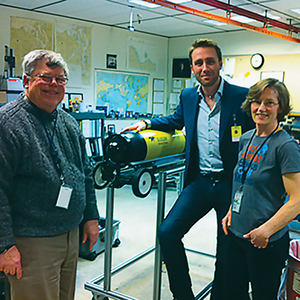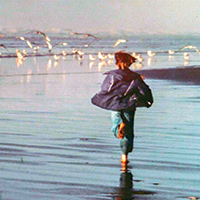The Journal of Irreproducible Results once published a paper calculating how quickly the Pacific and Atlantic coasts would sink into the sea from the weight of all the old magazines stored in their basements and attics. Mock science it might have been, but magazine hoarding has had real impact on ocean policy in this state and beyond — via Washington Sea Grant’s ocean acidification specialist, Meg Chadsey.
In 2010 Chadsey was a disenchanted fortysomething ex-microbiologist looking for an outlet for her real passion, the marine environment. After visiting her parents on Vashon Island, she left to catch a flight to Minneapolis. “Luckily, my parents never throw out magazines,” she says. She grabbed a 2006 issue of The New Yorker to read on the plane.
That issue happened to contain a seminal article by Elizabeth Kolbert, “The Darkening Sea,” on what was still a relatively esoteric phenomenon, ocean acidification. Chadsey was amazed and appalled to learn that carbon dioxide emitted by human activities and devices (including the plane she was on) was changing the basic chemistry of the world’s oceans and the prospects for the creatures in it. Unlike most people who get alarmed by something they read, she resolved to do something about it. “By the time the plane landed, I knew that this was what I wanted to do when I grew up.”
It had taken Chadsey a decade to find her calling, though it marked a return to her salt-sprayed roots. Growing up on Vashon, she’d spent every minute she could along Puget Sound: “The beach was my world.
Like half the biologists in the world, I started out wanting to be a marine biologist.”
But like so many childhood dreamers, she detoured. “In college I got distracted by recombinant DNA, which was just becoming mainstream then.” She became a molecular biologist — “a postdoc in this very nice lab [at UW] with very nice people. But it wasn’t my calling.”
Chadsey found herself sneaking down the block to attend seminars at the School of Fisheries and Aquatic Sciences (SAFS) and casting about for ways to combine two of her main interests: marine policy and sustainable foods. She collaborated with Tom Leschine, then director of UW’s School of Marine and Environmental Affairs, and NOAA algal bloom researcher Vera Trainer on a paper about how institutions responded when toxic algae started forcing razor clam closures on the coast. “I dabbled in marine issues, worked for the Marine Stewardship Council.” She assisted F.O.R.K.S. (previously Seattle Chefs Collaborative), a nonprofit promoting local, sustainable food sources. Caroline Gibson, who helped run a rockfish conservation group, worked with Chadsey during those days and marveled at her energy and perseverance: “She’s amazing — balls to the wall when she gets going on a project.”
And then Chadsey read that four-year-old article on ocean acidification (OA). She’d come late to the acidification issue, but she was a quick study. “With her chemistry background she understood this vast, complex issue long before I did,” says Gibson.
That winter, SAFS devoted its entire 2011 Bevan Series on Sustainable Fisheries to acidification. Chadsey attended every session; two speakers stood out. One was Richard Feely, a senior scientist at NOAA’s Pacific Marine Environmental Laboratory (PMEL), whose pioneering measurements of the carbon signal in upwelled deep-ocean waters revealed that the Northwest littoral is a frontline in acidification’s onset. The other was former Congressman Brian Baird, who had (with then-Congressman Jay Inslee) sponsored the only ocean acidification bill — funding research and monitoring — to make it through Congress. “The hard cold facts Dick Feely had were pretty devastating,” says Chadsey. “Fortunately they scheduled Brian Baird the next week. He didn’t bring good news, but if anybody can make you laugh about ocean acidification, it’s Brian. One thing he talks about is how people can digest really dispiriting information, what turns them off, and how they can engage on an issue.”
Baird threw out one little idea: to make message buttons (“square because people think round buttons look like political campaigns”) saying, “Ask me about pteropods” — the tiny swimming snails, a.k.a. “sea butterflies,” that are essential to the North Pacific food web, acutely vulnerable to acidifying water, and charismatic in a micro-species sort of way.
“I thought, ‘That’s easy’,” Chadsey recalls, and she had the buttons made. Baird says he still wears his and it still starts conversations.
That was just the start of the inspiration Chadsey drew from the Bevan talks. Feely and Baird — grim science plus irrepressible action — were an irresistible combination, she reasoned; they should be speaking not just to fisheries insiders at UW but to policymakers, media, the wider environmental community, even the general public. After each of them spoke, she strode up, introduced herself, and said she wanted to help get the word out. Then she cast about for a forum to do that.
She started at home. Chadsey’s husband, Matt, was a of the Sustainable Path Foundation, a group that sponsors an annual seminar series at Town Hall. “Do you think they’d go for an OA seminar?” Meg asked Matt. She wrote up a pitch and told the group, “If you’ll hold it, I’ll do all the legwork and get your speakers.” They told her to go ahead.
Once Baird and Feely committed, Chadsey started thinking. “It was likely Dick and Brian would be available the following day, too. What else could I do with them?”
Caroline Gibson, now with the Northwest Straits Commission, had an idea. She knew that Washington Sea Grant was interested in ocean acidification: Why not seek help there? Chadsey approached WSG director Penny Dalton and proposed a symposium on acidification, with a science panel anchored by Feely and a policy panel moderated by Baird. Again she volunteered to assemble and coordinate the program.
Dalton, like the others Chadsey called, was impressed. “It’s really unusual to have a volunteer come to us knowing exactly what she wants to do,” she recalls. “Particularly one as enthusiastic, experienced, and prepared as Meg was. For me it was very easy to say ‘Yes’.”
The symposium, held November 9, 2011 at UW’s Center for Urban Horticulture, surpassed everyone’s expectations. The crowd filled the hall’s 200 seats and all the available standing room; latecomers lined the back of the room. Feely explained the physical science of acidification, and three biologists — UW’s Carolyn Friedman and Terrie Klinger, and Western Washington University’s Brady Olson — described its effects on marine organisms. The policy panel ranged even more widely: from Makah Tribal Chairman Micah McCarty and Taylor Shellfish Policy Director Bill Dewey to journalist (now WSG science writer) Eric Scigliano and Ron Sims, the environmentally minded former King County executive and deputy director of the U.S. Department of Housing and Urban Development.
Again, Chadsey took advantage of a fortunate connection. David Dicks, the director of the state Puget Sound Partnership, lived across the street from her in Wallingford. When all other attempts to reach Sims failed, Dicks made the connection. But she did not think to ask him to invite his own father, Norm Dicks, Washington’s senior congressional representative, whose long record of securing federal funding for local marine conservation earned him the sobriquet “the congressman from Puget Sound.”
Nevertherless, late in the symposium, “Stormin’ Norman” rose from the audience and delivered a ringing pep talk for the effort to understand and deal with acidification. That was just one of two big surprises that day.
Neither Chadsey nor anyone else knew what Ron Sims would say. In steam-rolling style, Sims (who’s also an ordained Baptist minister) delivered a passionate version of President Franklin D. Roosevelt’s famous line, “Okay, you’ve convinced me, now go out there and put some pressure on me.”
“Acidification, we have to deal with it and we have to deal with it early,” Sims declared. The question is, how do we do that, because we cannot do everything.” Boil it down, he urged. Cut the fancy explanations and give us political and policy types concrete steps we can take to fix it. “Step one, step two, step three — provide a clear, concise program!”
One pair of ears that perked up upon hearing this belonged to Brad Warren, a veteran journalist who had labored for nearly five years to mobilize the fishing industry to confront acidification. “Several of us there turned to each other and said, ‘Did you hear what I heard? Yeah! He just gave us an actionable challenge.”
Warren immediately drafted a two-page memo laying out a program for state action on acidification. After vetting it with Feely and Klinger, he handed it off to two compatriots he knew had then-Governor Chris Gregoire’s ear: Bill Dewey and Terry Williams, the Tulalip Tribes’ fisheries and natural resources commissioner. Dewey had earlier helped prod Gregoire to launch the state’s Shellfish Initiative, directed toward boosting both shellfish growing and water quality. Now he and Williams urged her to add acidification to the brief. Four weeks after the symposium, she announced the formation of a blue-ribbon panel that would bring research, government, environmental, and industry sectors together to sift strategies for mitigating, remediating, and adapting to acidification. Washington Sea Grant, NOAA, the Rockefeller Brothers Foundation, the Washington Department of Ecology, U.S. EPA, UW’s Climate Impacts Group, and Warren’s Global Ocean Health Program kicked in money and staff time.
The panel met intensively through the spring and summer of 2012, but the toughest work unfolded into the autumn, backstage, in a flurry of report writing and committee-level debate. Chadsey was at the center of it, staffing the panel’s education and outreach committee, assisting the committee on mitigation and remediation, and helping write and edit the scientific report, riding herd on the overbooked scientists to write their portions, rounding up photos for the final panel report, and in a hundred unsung ways keeping the process on track.
The report’s impact was immediate in Washington, and it continues to ripple far beyond the state’s borders. The state promptly funded a UW research center on acidification and new chemical monitoring of local waters. Other states (seven by Warren’s count) have since undertaken their own acidification initiatives, often closely following the Washington panel’s model and using its scientific findings.
Chadsey speaks modestly about how all this took her by surprise: “I didn’t realize for a while how unique Washington was, how we’re in a position to be a global leader.” But Warren thinks her focus on Washington set the stage for the state to become a national trailblazer. Few now recall that his Global Ocean Health Program and the Marine Conservation Institute hosted an earlier symposium on acidification at UW, the year before the Sea Grant-sponsored event. “But we and others saw it as something we had to address at the federal level,” Warren recalls. “We invited a lot of congressmen — Dicks, Inslee, and Baird came. There was a big push to put ocean acidification on Congress’s agenda. But Congress was essentially stuck — it was not ready to pass any legislation. The focus on the federal level really led to deadlock.
“Meg understood what we didn’t: that action had to come at the state level. She deserves credit for helping advance this. She pulled the cork out. The first state to create a comprehensive strategy to address acidification was Washington, and she created the conversation that led to that.”
That conversation continues. Two years ago the Paul G. Allen Family Foundation issued its “Ocean Challenge,” with a $10,000 prize to the most promising strategy for addressing ocean acidification. Others proposed ideas for monitoring or adapting to acidification. But a team of local researchers, led by shellfish scientist Joth Davis, and Betsy Peabody of the Puget Sound Restoration Fund, proposed remediating the acidified waters themselves by growing and harvesting large arrays of carbon-extracting seaweed — an idea explored during the Blue Ribbon Panel process. This idea didn’t win the marquee prize, which went to a Hawaiian–Australian team’s proposal for breeding resilient reef corals. But it was one of very few that the Allen Foundation eventually funded.
Again, Chadsey was in the thick of it, from the initial brainstorming over strategies —“We just sort of proposed ideas and then shot them down”— to the drafting of both the initial concept and the full proposal. In her newer role as Washington Sea Grant OA Specialist and liaison to PMEL, where she works with Feely, she’s continued to find new ways to alert and educate the public about ocean acidification. She speaks to groups and schools; has put together widely distributed OA fact sheets and other printed and posted materials; helps maintain an online collection of OA curricula for students and teachers, in partnership with the Suquamish Tribe; and trains students from Bainbridge Island and Seattle high schools to monitor OA in Puget Sound.
“There are three kinds of people,” says Brian Baird. “Those who see what’s needed but don’t act. Those who would act but don’t see the need. And those who get it and act on it. Meg’s the third. Not only does she understand the problem, she acts to correct it. She makes a commitment and sticks with it. She’s really extraordinary.”
All the more so because she moved mountains without any of the usual levers — professional credentials (though her science background served her well), political clout, an influential position, or even funding. “She’s proof,” says Dalton, “of the African proverb, ‘If you think you’re too small to be effective, you haven’t been in the dark with a mosquito.’”

